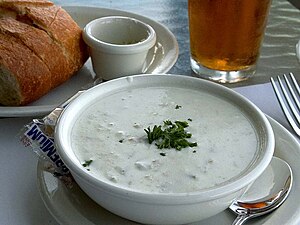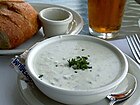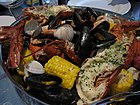This is the current revision of this page, as edited by GreenC bot (talk | contribs) at 04:13, 17 November 2024 (Move 1 url. Wayback Medic 2.5 per WP:URLREQ#time.com). The present address (URL) is a permanent link to this version.
Revision as of 04:13, 17 November 2024 by GreenC bot (talk | contribs) (Move 1 url. Wayback Medic 2.5 per WP:URLREQ#time.com)(diff) ← Previous revision | Latest revision (diff) | Newer revision → (diff) Soup containing clams and broth or milk
 New England clam chowder. New England clam chowder. | |
| Type | Chowder |
|---|---|
| Place of origin | United States |
| Region or state | New England |
| Invented | 18th century |
| Main ingredients | Clams, potatoes, salt pork, and onions. Cream or tomatoes may be added. |
| Variations | New England clam chowder, Manhattan clam chowder, Rhode Island clam chowder, others |
Clam chowder is any of several chowder soups in American cuisine containing clams. In addition to clams, common ingredients include diced potatoes, salt pork, and onions. Other vegetables are not typically used. It is believed that clams were used in chowder because of the relative ease of harvesting them. Clam chowder is usually served with saltine crackers or small, hexagonal oyster crackers.
The dish originated in the Northeastern United States, but is now commonly served in restaurants throughout the country. Many regional variations exist, but the three most prevalent are New England or "white" clam chowder, which includes milk or cream, Manhattan or "red" clam chowder, which includes tomatoes, and Rhode Island or "clear" clam chowder, which omits both.
History
Early documentation of "clam chowder" as we know it today did not contain milk and was thickened during cooking using crackers or stale bread. The first recipe for Manhattan clam chowder, with tomatoes and no milk, was published before 1919, and the current name was attested in 1934.
Primary variants and styles
As recipes for clam chowder spread throughout the United States in the 19th and 20th centuries, many regionally developed variants have arisen.
Manhattan clam chowder

Manhattan clam chowder has a red, tomato-based broth and unlike New England clam chowder there is no milk or cream. Manhattan-style chowder also usually contains other vegetables, such as celery and carrots to create a mirepoix. Thyme is often used as a seasoning.
Many sources attribute its creation to Rhode Island's Portuguese fishing communities who were known both for their traditional tomato-based stews and for their frequent travels to New York City's Fulton Fish Market during the mid-1800s. While Rhode Island clam chowder is clear, it was relatively common in Rhode Island for some cooks to add tomato sauce to their chowder. In Rhode Island this style chowder is also frequently referred to as "Rocky Point Clam Chowder" as it was a popular menu item at the Rocky Point Amusement Park Shore Dinner Hall since the park opened in 1847.
This chowder was at times called by various names including "Clam Chowder – Coney Island Style" (1893). Manhattan clam chowder is included in Victor Hirtzler's Hotel St. Francis Cookbook (1919) and "The Delmonico Cook Book" (1890) as "clam chowder". The "Manhattan" name is first attested in a 1934 cookbook.
New England clam chowder
New England clam chowder, occasionally referred to as Boston or Boston-style clam chowder, is a milk- or cream-based chowder, and is often of a thicker consistency than other regional styles. It is commonly made with milk, butter, potatoes, salt pork, onion, and clams. Flour or, historically, crushed hard tack may be added as a thickener.
New England clam chowder is usually accompanied by oyster crackers. Crackers may be crushed and mixed into the soup for thickener, or used as a garnish.
Rhode Island clam chowder
Rhode Island clam chowder is made with clear broth, and contains no dairy or tomatoes. It is common in southeastern Rhode Island through eastern Connecticut. In Rhode Island, it is sometimes called "South County Style" referring to Washington County, where it apparently originated.
Long Island clam chowder
Long Island clam chowder is part New England–style and part Manhattan-style, making it a pinkish creamy tomato clam chowder. The name is intended as humorous: Long Island is between Manhattan and New England. The two parent chowders are typically cooked separately before being poured in the same bowl. This variant is popular in many small restaurants across Suffolk County, New York.
Hatteras clam chowder
Served throughout North Carolina's Outer Banks region, this variation of clam chowder has clear broth, bacon, potatoes, onions, and flour as a thickening agent. It is usually seasoned with copious amounts of white and/or black pepper, but occasionally with chopped green onions or even hot pepper sauce.
Minorcan clam chowder
Minorcan clam chowder is a spicy traditional version found in Florida restaurants near St. Augustine and the northeast corner of the Sunshine State. It has a tomato broth base, with a "secret ingredient", Spanish datil pepper, an extremely hot chili comparable to the habanero.
See also
- Bisque
- Corn chowder
- Cream of mushroom soup
- Fish stew
- List of clam dishes
- List of cream soups
- List of fish and seafood soups
- List of regional dishes of the United States
- Oyster stew
References
- ^ Correa, Cynthia (January 31, 2016). "A Brief History of Clam Chowder". Eater. Vox Media, LLC. Archived from the original on August 30, 2018. Retrieved August 21, 2016.
- Sanburn, Josh (January 31, 2012). "Manhattan Clam Chowder vs. New England Clam Chowder". Time. Retrieved August 21, 2016.
- "History of Chowder, History of Clam Chowder, History of Fish Chowder". Whatscookingamerica.net. Retrieved December 1, 2007.
- Swiers, Autumn (December 22, 2022). "The 3 Most Popular Types Of Clam Chowder, Explained". Tasting Table. Static Media. Retrieved July 5, 2024.
- Child, Lydia (1832). The American Frugal Housewife. Carter, Hendee, & Company. p. 59.
- ^ Hirtzler, Victor (1919). The Hotel St. Francis cook book. p. 363.
- ^ "The Scoop on Different Types of Clam Chowder". Your AAA Network. February 19, 2020. Retrieved February 26, 2020.
- "The Essential Rhode Island Quahog Guide". RI Monthly. September 1, 2020. Retrieved June 3, 2021.
- "Rocky Point Clam Chowder". Rocky Point Recipes. Retrieved June 14, 2021.
- "The Rocky Point Shore Dinner Hall". Bygone Food and Recipes. January 31, 2010. Retrieved June 14, 2021.
- Whitehead, Jessup (1893). Cooking for Profit. The author. p. 98.
- Filippini, Alessandro (1890). The Delmonico Cook Book. Applewood Books. p. 152. ISBN 9781429011747.
- Hirtzler, Victor (1919). The Hotel St. Francis cook book. p. 84.
- Fannie Merritt Farmer, The Boston Cooking-School Cook Book, 1896, p. 128
- Oliver, Sandy (March 27, 2008). "The Crown Pilot Cracker Escapade: 11 Years Later". The Working Waterfront.
- "Long Island Clam Chowder: Secret Blend Slowly Catching On". Long Island Press. September 4, 2013. Retrieved October 29, 2015.
- Louis Imbroto. "Long Island clam chowder?". Young Island. Archived from the original on January 21, 2015. Retrieved October 29, 2015.
- "Hatteras-Style Clam Chowder Is A Carolina Tradition". Southern Living. Retrieved July 23, 2024.
- Stancil, Ryan (May 30, 2023). "Soup from the Sound". Our State. Retrieved July 23, 2024.
- "Minorcan Clam Chowder by Mary Ellen Masters, 'The Queen of Chowder'". Totally St. Augustine. Retrieved July 23, 2024.
External links
| Cuisine of New England | ||
|---|---|---|
| Soups and stews |    | |
| Sandwiches | ||
| Seafood dishes | ||
| Baked dishes | ||
| Sauces and condiments | ||
| Desserts and sweets | ||
| Beverages | ||
| Miscellaneous | ||
| Breads | ||
| Related topics | ||